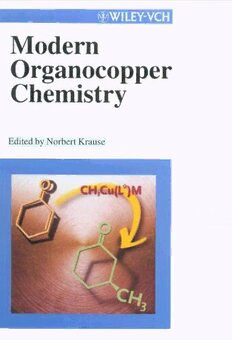
Modern Organocopper Chemistry PDF
Preview Modern Organocopper Chemistry
ModernOrganocopperChemistry.EditedbyNorbertKrause Copyright>2002Wiley-VCHVerlagGmbH ISBNs:3-527-29773-1(Hardcover);3-527-60008-6(Electronic) EditedbyN.Krause ModernOrganocopper Chemistry ModernOrganocopperChemistry.EditedbyNorbertKrause Copyright>2002Wiley-VCHVerlagGmbH ISBNs:3-527-29773-1(Hardcover);3-527-60008-6(Electronic) Related Titles from Wiley-VCH Togni,Antonio/Gruu€tzmacher,Hansjoo€rg(eds.) Catalytic Heterofunctionalization FromHydroaminationtoHydrozirconation 2001,ISBN3-527-30234-4 Kobayashi,Shu/Jørgensen,KarlAnker(eds.) Cycloaddition Reactions in Organic Synthesis 2001,ISBN3-527-30159-3 Beller,Matthias/Bolm,Carsten(eds.) Transition Metals for Organic Synthesis BuildingBlocksandFineChemicals 1998,ISBN3-527-29501-1 Cornils,Boy/Herrmann,WolfgangA.(eds.) Aqueous-Phase Organometallic Catalysis ConceptsandApplications 1998[EN],ISBN3-527-29478-3 ModernOrganocopperChemistry.EditedbyNorbertKrause Copyright>2002Wiley-VCHVerlagGmbH ISBNs:3-527-29773-1(Hardcover);3-527-60008-6(Electronic) Edited by Norbert Krause Modern Organocopper Chemistry ModernOrganocopperChemistry.EditedbyNorbertKrause Copyright>2002Wiley-VCHVerlagGmbH ISBNs:3-527-29773-1(Hardcover);3-527-60008-6(Electronic) Editor 9 Thisbookwascarefullyproduced. Nevertheless,editor,authorsandpublisher Prof.Dr.N.Krause donotwarranttheinformationcontained UniversityofDortmund thereintobefreeoferrors.Readersare OrganicChemistryII advisedtokeepinmindthatstatements, D-44221Dortmund data,illustrations,proceduraldetailsor Germany otheritemsmayinadvertentlybe inaccurate. LibraryofCongressCardNo.:appliedfor BritishLibraryCataloguing-in-Publication Data Acataloguerecordforthisbookisavailable fromtheBritishLibrary. DieDeutscheBibliothek–CIPCataloguing- in-PublicationData Acataloguerecordforthispublicationis availablefromDieDeutscheBibliothek (2002WILEY-VCHGmbH,Weinheim Allrightsreserved(includingthoseof translationinotherlanguages).Nopartof thisbookmaybereproducedinanyform– byphotoprinting,microfilm,oranyother means–nortransmittedortranslatedinto amachinelanguagewithoutwritten permissionfromthepublisher.Registered names,trademarks,etc.usedinthisbook, evenwhennotspecificallymarkedassuch, arenottobeconsideredunprotectedby law. PrintedintheFederalRepublicof Germany Printedonacid-freepaper Composition AscoTypesetters,Hong Kong Printing StraussOffsetdruckGmbH Mo¨rlenbach Bookbinding WilhelmOsswald&Co., Neustadt ISBN 3-527-29773-1 ModernOrganocopperChemistry.EditedbyNorbertKrause Copyright>2002Wiley-VCHVerlagGmbH ISBNs:3-527-29773-1(Hardcover);3-527-60008-6(Electronic) v Foreword Copper is one of the oldest transition metals to be used in synthetic organic chemistry. Starting in the 60’s, organocopper reagents became among the most popularsynthetictoolsinthetotalsynthesisofnaturalproduct.Thisisduetothe ease of handling and to the chemo-, regio- and stereoselectivities attained with these reagents. Their unique properties for the conjugate addition, for the clean S 2 substitution, for the mild opening of epoxides, for the carbometallation of N triple bonds, etc ... makes them unavoidable reagents for these synthetic trans- formations. Overtheyears,awholefamilyofreagentsevolvedwithincreasedselectivityand reactivity. ‘‘Homocuprates’’, ‘‘heterocuprates’’, ‘‘higher order cuprates’’, ‘‘mixed cuprates’’, and others, are terms often employed, and a newcomer chemist may worry about their different properties. Despite a lot of progress in the area of organocopperchemistrythereisstillastronglackofknowledgeinthemechanistic insights. No reactive intermediates have been trapped, and this ‘‘black box’’ was only considered through analogies with other closely related transition metals or, morerecently,throughextensivecalculations.Thisistosaythatallourknowledge about organocopper chemistry did not came by rational design but through em- piricalwaywithexperimentation. Overtheyears,severalreviewarticlesappearedonorganocopperchemistry.Most often, they cover some aspects or some restricted class of reagents, and they are addressed to chemists knowing already the main reactions of organocopper re- agents. In contrast to other transition metals, such as Pd, Ni, Rh etc ... only few books, covering the entire area of organocopper chemistry, have been published. Thepresentbookisthemostcomprehensiveandallthemostrecentadvancesare extensively discussed: Zn-Cu reagents, Sn and Si-Cu reagents, H-Cu reagents, asymmetric reactions. The reader will learn about the structure of organocopper reagentsandaboutthemostupdatedmechanisticbeliefspresentlyknown. Organocopper chemistry is of wide applicability, very efficient and easy to per- form. The main problem is to know the most appropriate reagent to use. The reader will find in this book all the details for the reagent of choice, for the scope and limitations, for the type of substrate needed. This book should be helpful not onlytoadvancedresearchchemists,butalsoforteachingthischemistrytoyounger vi Foreword students inacomprehensive andmodernway.Suchawidecoverageofanimpor- tantpieceofchemistryisnotonlywelcome;itwasneeded! December2001 ProfessorAlexandreAlexakis UniversityofGeneva Geneva ModernOrganocopperChemistry.EditedbyNorbertKrause Copyright>2002Wiley-VCHVerlagGmbH ISBNs:3-527-29773-1(Hardcover);3-527-60008-6(Electronic) vii Contents Foreword v Preface xi ListofAuthors xiii 1 StructuresandReactivitiesofOrganocopperCompounds 1 JohannT.B.H.Jastrzebski,GerardvanKoten 1.1 Introduction 1 1.1.1 HistoricalPerspective 1 1.1.2 TheOxidationStatesofCopper 3 1.1.3 ThermalStabilityandBondinginOrganocopper(I)Compounds 6 1.2 HomolepticOrganocopperCompoundsCunRn 8 1.3 HeterolepticOrganocopperCompoundsCunBmRnXm 17 1.4 Organocuprates 26 1.4.1 NeutralHomolepticandHeterolepticOrganocuprates 27 1.4.2 AnionicHomolepticandHeterolepticOrganocuprates 32 1.4.3 Lower-andHigher-orderCyanocuprates 34 1.5 ConcludingRemarks 37 Acknowledgement 40 References 40 2 TransmetalationReactionsProducingOrganocopperReagents 45 PaulKnochel,BodoBetzemeier 2.1 Introduction 45 2.2 TransmetalationofFunctionalizedOrganolithiumandOrganomagnesium Reagents 45 2.3 TransmetalationofOrganoboronandOrganoaluminiumReagents 51 2.4 TransmetalationofFunctionalizedOrganozincReagents 54 2.4.1 PreparationofOrganozincReagents 54 2.4.1.1 PreparationofOrganozincHalides 56 2.4.1.2 PreparationofDiorganozincReagents 59 2.4.2 SubstitutionReactionswithCopper-ZincReagents 62 2.4.3 AdditionReactionswithCopper-ZincReagents 65 2.5 TransmetalationofOrganotin,Organosulfur,andOrganotellurium Reagents 67 viii Contents 2.6 TransmetalationofOrganotitaniumandOrganomanganeseReagents 70 2.7 TransmetalationofOrganozirconiumandOrganosamariumReagents 71 2.8 Conclusion 74 References 75 3 Heteroatomcupratesanda-HeteroatomalkylcupratesinOrganicSynthesis 79 R.KarlDieter 3.1 Introduction 79 3.2 Heteroatomcuprates 80 3.2.1 GroupIVAHeteroatoms(Si,Ge,Sn) 80 3.2.1.1 ConjugateAdditionReactions 83 3.2.1.2 SilylcuprationandStannylcuprationofAlkynesandAllenes 93 3.2.1.3 SubstitutionReactions 102 3.2.2 GroupVAandVIAHeteroatoms(N,O,P) 108 3.3 a-Heteroatomalkylcuprates 109 3.3.1 GroupVIHeteroatoms(O,S,Se) 110 3.3.2 GroupVHeteroatoms(N,P)andSilicon 114 3.3.3 a-Fluoroalkylcupratesanda-Fluoroalkenylcuprates 122 3.4 Non-transferableHeteroatom(alkyl)cupratesanda- Heteroatomalkylcuprates 123 3.4.1 SimpleResidualLigands 124 3.4.2 ChiralLigands 127 3.5 Summary 133 Acknowledgments 134 References 134 4 Copper-mediatedAdditionandSubstitutionReactionsofExtendedMultiple BondSystems 145 NorbertKrause,AnjaHoffmann-Ro¨der 4.1 Introduction 145 4.2 Copper-mediatedAdditionReactionstoExtendedMichaelAcceptors 146 4.2.1 Acceptor-substitutedDienes 146 4.2.2 Acceptor-substitutedEnynes 150 4.2.3 Acceptor-substitutedPolyenynes 159 4.3 Copper-mediatedSubstitutionReactionsofExtendedSubstrates 160 4.4 Conclusion 162 References 163 5 Copper(I)-mediated1,2-and1,4-Reductions 167 BruceH.Lipshutz 5.1 IntroductionandBackground 167 5.2 MoreRecentDevelopments:StoichiometricCopperHydrideReagents 168 5.3 1,4-ReductionsCatalyticinCu(I) 174 5.4 1,2-ReductionsCatalyzedbyCopperHydride 179 5.5 HeterogeneousCuH-CatalyzedReductions 182 5.6 OverviewandFutureDevelopments 184 References 185 Contents ix 6 Copper-mediatedDiastereoselectiveConjugateAdditionandAllylicSubstitution Reactions 188 BernhardBreit,PeterDemel Abstract 188 6.1 ConjugateAddition 188 6.1.1 StereocontrolinCyclicDerivatives 188 6.1.2 StereocontrolinAcyclicDerivatives 192 6.1.2.1 g-Heteroatom-substitutedMichaelAcceptors 192 6.1.2.2 g-Alkyl-substituteda,b-UnsaturatedCarbonylDerivatives 198 6.1.2.3 a,b-UnsaturatedCarbonylDerivativeswithStereogenicCentersin Positionsotherthantheg-Position 200 6.1.2.4 DirectedConjugateAdditionReactions 200 6.1.3 Auxiliary-boundChiralMichaelAcceptorsandAuxiliaryChiralMetal Complexes 202 6.2 AllylicSubstitution 210 References 218 7 Copper-catalyzedEnantioselectiveConjugateAdditionReactionsofOrganozinc Reagents 224 BenL.Feringa,RobertNaasz,RosalindeImbos,LeggyA.Arnold 7.1 Introduction 224 7.2 OrganozincReagents 227 7.3 Copper-catalyzed1,4-Addition 229 7.3.1 Phosphoramidite-basedCatalysts 229 7.3.2 CatalyticCycle 233 7.3.3 VariationofLigands 234 7.3.4 CyclicEnones 239 7.3.5 2-Cyclopentenone 240 7.3.6 AcyclicEnones 242 7.4 SyntheticApplications 243 7.4.1 TandemConjugateAddition-AldolReactions 243 7.4.2 KineticResolutionof2-Cyclohexenones 243 7.4.3 Sequential1,4-Additionsto2,5-Cyclohexadienones 246 7.4.4 Lactones 250 7.4.5 Nitroalkenes 250 7.4.6 AnnulationMethodology 252 7.5 Conclusions 254 Acknowledgements 255 ReferencesandNotes 255 8 Copper-MediatedEnantioselectiveSubstitutionReactions 259 A.SofiaE.Karlstro¨m,Jan-ErlingBa¨ckvall 8.1 Introduction 259 8.2 AllylicSubstitution 261 8.2.1 AllylicSubstrateswithChiralLeavingGroups 262 8.2.2 ChiralAuxiliarythatisCleavedoffaftertheReaction 268
